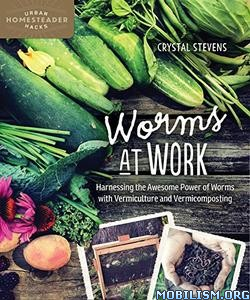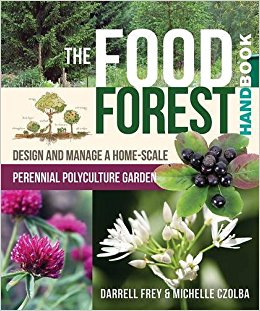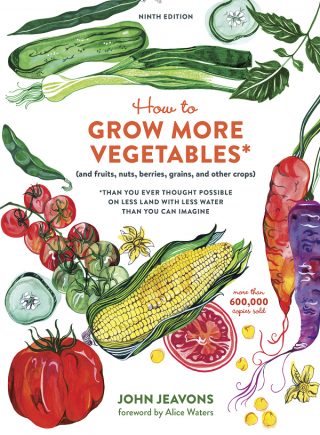Worms at Work, The Food Forest Handbook, & How to Grow More Vegetables
Posted in From the Library on September 4 2017, by Esther Jackson
Esther Jackson is the Public Services Librarian at NYBG’s LuEsther T. Mertz Library where she manages Reference and Circulation services and oversees the Plant Information Office. She spends much of her time assisting researchers, providing instruction related to library resources, and collaborating with NYBG staff on various projects related to Garden initiatives and events.
 Worms at Work: Harnessing the awesome power of worms with vermiculture and vermicomposting is a new book on home composting from Crystal Stevens and New Society Publishers. The book includes some general introductory information for those interested in starting home worm composting operations and also includes a few activities for teachers who want to use compost and worms in the classroom. Local readers interested in learning more about home composting and home worm bins should check out the NYC Compost Project funded by the NYC Department of Sanitation and hosted by the New York Botanical Garden in the Bronx.
Worms at Work: Harnessing the awesome power of worms with vermiculture and vermicomposting is a new book on home composting from Crystal Stevens and New Society Publishers. The book includes some general introductory information for those interested in starting home worm composting operations and also includes a few activities for teachers who want to use compost and worms in the classroom. Local readers interested in learning more about home composting and home worm bins should check out the NYC Compost Project funded by the NYC Department of Sanitation and hosted by the New York Botanical Garden in the Bronx.
 Another recent book from New Society Publishers is The Food Forest Handbook: Design and manage a home-scale perennial polyculture garden by Darrell Frey and Michelle Czolba. In part, this book documents the work that went into building the Hazelwood Food Forest in Pittsburgh, PA. As a record of that garden, this book is interesting. As a resource for those starting their own food forests, however, the content is a little dubious. While Frey and Czolba provide some good, general guidelines for new food foresters, their plant palette includes some known problem species, including Artemisa vulgaris (mugwort) and Rumex (dock/sorrel). In addition to that warning bell, a brief and error-laden introduction to taxonomy is another indication that the editorial process for this book could have been more rigorous. Frey and Czolba mean well, and hopefully their enthusiasm will inspire others who want to build community food forests without doing too much damage by encouraging the planting of problem non-native species.
Another recent book from New Society Publishers is The Food Forest Handbook: Design and manage a home-scale perennial polyculture garden by Darrell Frey and Michelle Czolba. In part, this book documents the work that went into building the Hazelwood Food Forest in Pittsburgh, PA. As a record of that garden, this book is interesting. As a resource for those starting their own food forests, however, the content is a little dubious. While Frey and Czolba provide some good, general guidelines for new food foresters, their plant palette includes some known problem species, including Artemisa vulgaris (mugwort) and Rumex (dock/sorrel). In addition to that warning bell, a brief and error-laden introduction to taxonomy is another indication that the editorial process for this book could have been more rigorous. Frey and Czolba mean well, and hopefully their enthusiasm will inspire others who want to build community food forests without doing too much damage by encouraging the planting of problem non-native species.
 How to Grow More Vegetables (and fruits, nuts, berries, grains, and other crops) than you ever thought possible on less land with less water than you can imagine by John Jeavons is now in its 9th edition and still as useful as ever. First published in 1974, this work remains relevant for and accessible to beginner, intermediate, and advanced home gardeners. Jeavons, one of the leaders in biointensive/biodynamic agriculture in the last century, carefully takes readers through ways to prepare their vegetable gardens for high-yield crops using sustainable methods. Does that idea sound familiar? That’s because this work has remained in vogue for over forty years, inspiring vegetable-growing gardeners the world over. An important resource for the home grower, the 9th edition includes new information about using less water and increasing compost power. The first edition was “dedicated to the plants, animals, insects, rain, planets, people, soil, micro-organisms, flowers, herbs, weeds, forces of nature, and love which have made this method, book, and life possible.” The 2017 edition, filled with additional scholarly information and more detailed illustrations, continues that tradition and spirit.
How to Grow More Vegetables (and fruits, nuts, berries, grains, and other crops) than you ever thought possible on less land with less water than you can imagine by John Jeavons is now in its 9th edition and still as useful as ever. First published in 1974, this work remains relevant for and accessible to beginner, intermediate, and advanced home gardeners. Jeavons, one of the leaders in biointensive/biodynamic agriculture in the last century, carefully takes readers through ways to prepare their vegetable gardens for high-yield crops using sustainable methods. Does that idea sound familiar? That’s because this work has remained in vogue for over forty years, inspiring vegetable-growing gardeners the world over. An important resource for the home grower, the 9th edition includes new information about using less water and increasing compost power. The first edition was “dedicated to the plants, animals, insects, rain, planets, people, soil, micro-organisms, flowers, herbs, weeds, forces of nature, and love which have made this method, book, and life possible.” The 2017 edition, filled with additional scholarly information and more detailed illustrations, continues that tradition and spirit.


Esther,
Thank you for reviewing our book, The Food Forest Handbook. I wanted to say that we included some wild edible and medicinal plants to let the reader know that if they are present , they maybe of use. On page 80 we do give warning about invasive plants. I am not sure that our taxonomy sidebar is laden with errors, but I would be happy to be educated wabout where we are in error.
Again, we appreciate being mentioned in your blog.
Darrell
http://www.threesisterspermaculture.com